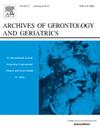打破恶性循环:社会孤立和功能残疾之间的相互影响以及数字包容的缓冲作用
IF 3.5
3区 医学
Q2 GERIATRICS & GERONTOLOGY
引用次数: 0
摘要
在日本等老龄化社会,社会隔离(SI)和功能残疾(FD)严重影响老年人的健康,但它们之间的双向关系和潜在的调节因素仍未得到充分探讨。本前瞻性队列研究考察了双向SI-FD关联,并测试了数字包容(DI)在日本社区老年人中的调节作用。我们使用多组随机截距交叉滞后面板模型(RI-CLPM)对480名年龄≥65岁的成年人进行了三波分析(基线、3年、6年随访),以分离人与人之间和人与人之间的影响。在人际水平上,SI与FD呈正相关(β = 0.50, p <;0.001)。在个体内,SI和FD表现出随时间的相互恶化,SI对随后的FD有交叉滞后效应(T1→T2: β = 0.42, p <;0.001;T2→T3: β = 0.40, p <;0.001)超过FD对SI的影响(T1→T2: β = 0.21, p <;0.01;T2→T3: β = 0.29, p <;0.01)。DI显著减弱了SI的不良影响:在数字纳入组(n = 291)中,SI对FD的自回归效应和交叉滞后效应变得不显著(p >;0.05), SI对后续FD的交叉滞后效应也减弱(T1→T2: β = 0.19, p <;0.05;T2→T3: β = 0.22, p <;0.05)。研究结果表明,数字参与部分缓解了双向SI-FD链接。虽然社会干预仍然至关重要,但整合数字扫盲计划可能会破坏SI对残疾的级联效应。研究的局限性包括区域抽样和自我报告的措施。未来的研究应该在不同的人群中验证这些机制,并探索有针对性的数字社会混合干预措施。本文章由计算机程序翻译,如有差异,请以英文原文为准。
Breaking the vicious cycle: Reciprocal influences between social isolation and functional disability and the buffering effect of digital inclusion
In aging societies like Japan, social isolation (SI) and functional disability (FD) critically impact older adults’ health, yet their bidirectional relationship and potential moderators remain underexplored. This prospective cohort study examined the bidirectional SI-FD association and tested digital inclusion’s (DI) moderating role among community-dwelling Japanese older adults.
We analyzed 480 adults aged ≥65 across three waves (baseline, 3-year, 6-year follow-ups) using multi-group random intercept cross-lagged panel models (RI-CLPM) to disentangle within-person and between-person effects.
At the between-person level, SI was positively connected with FD (β = 0.50, p < 0.001). Within individuals, SI and FD demonstrated reciprocal worsening over time, with SI’s cross-lagged effect on subsequent FD (T1→T2: β = 0.42, p < 0.001; T2→T3: β = 0.40, p < 0.001) exceeding FD’s effect on SI (T1→T2: β = 0.21, p < 0.01; T2→T3: β = 0.29, p < 0.01). DI significantly attenuated SI’s adverse impacts: in the digitally included group (n = 291), SI’s autoregressive effects and cross-lagged effects on FD became nonsignificant (p > 0.05), SI’s cross-lagged effect on subsequent FD also weakened (T1→T2: β = 0.19, p < 0.05; T2→T3: β = 0.22, p < 0.05).
Findings suggest bidirectional SI-FD links are partially mitigated by digital engagement. While social interventions remain critical, integrating digital literacy programs may disrupt SI’s cascading effects on disability. Study limitations include regional sampling and self-reported measures. Future research should validate these mechanisms across diverse populations and explore targeted digital-social hybrid interventions.
求助全文
通过发布文献求助,成功后即可免费获取论文全文。
去求助
来源期刊
CiteScore
7.30
自引率
5.00%
发文量
198
审稿时长
16 days
期刊介绍:
Archives of Gerontology and Geriatrics provides a medium for the publication of papers from the fields of experimental gerontology and clinical and social geriatrics. The principal aim of the journal is to facilitate the exchange of information between specialists in these three fields of gerontological research. Experimental papers dealing with the basic mechanisms of aging at molecular, cellular, tissue or organ levels will be published.
Clinical papers will be accepted if they provide sufficiently new information or are of fundamental importance for the knowledge of human aging. Purely descriptive clinical papers will be accepted only if the results permit further interpretation. Papers dealing with anti-aging pharmacological preparations in humans are welcome. Papers on the social aspects of geriatrics will be accepted if they are of general interest regarding the epidemiology of aging and the efficiency and working methods of the social organizations for the health care of the elderly.

 求助内容:
求助内容: 应助结果提醒方式:
应助结果提醒方式:


